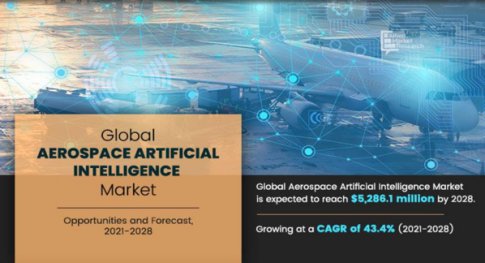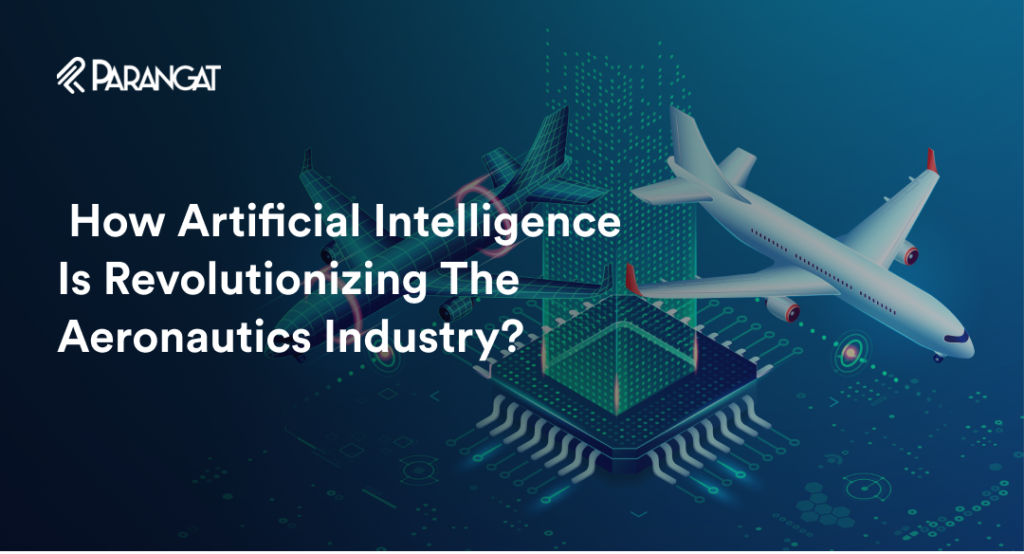In this blog post, we will explore how AI In Aeronautics is helpful across the industry. Artificial intelligence enables experts to access historical and current data anywhere in the Aeronautics industry. The mobile and desktop solutions provide warnings and notifications of the aircraft’s current technical status and assist technicians in identifying problems that could indicate a breakdown and replacing parts early. The artificial market for the aerospace sector is expected to grow from its 2020 valuation of $373.6 million to $5,826.1 million in 2028, a CAGR of 43.4%.

What is Artificial Intelligence?
Artificial intelligence, or AI for short, imitates human mental processes through computers, particularly computer systems. Specialized systems, natural language processing, speech recognition, and computer vision are some examples of specific uses of AI. Any human-like behavior a machine or system exhibits is called artificial intelligence or AI. In the most basic type of AI, computers are taught to “imitate” human behavior utilizing extensive data from prior instances of behavior that is similar to that being emulated. This can range from distinguishing between a cat and a bird to carrying out complicated tasks in a production setting.
AI systems include massive volumes of labeled training data, which then examine the data for patterns and models before employing these models to forecast future states. By studying millions of examples, an image recognition program may learn how to recognize and describe items in photographs, and a chatbot powered by examples of text chats can learn to make realistic exchanges with people. Three cognitive abilities have been emphasized in AI programming: learning, reasoning, and self-correction.
AI is significant because it may provide businesses with operational insights they previously might not have had. AI has the potential to outperform humans in some activities. AI systems frequently execute work quickly and with few errors, especially in repeated, thorough activities like analyzing numerous legal papers to ensure the correct fields are filled correctly.
Uses Of AI In the Aeronautics Industry
Businesses can streamline the production of numerous components and lessen security issues by implementing AI in the aerospace industry’s development. In addition, compared to manual inspections, AI systems can analyze feedback from many assets and handle vast amounts of data more quickly. Let’s know some of the top uses of AI in aeronautic industry:
-
Product Designing
Like every sector, aviation often favors affordable and reliable airplane parts. To create such components, automakers can add generative structures with AI algorithms. Iterative design is a process where technologists or architects work together to create a perfect product by using design criteria as input along with constraints and features, including materials, available assets, and a limited budget.
Advanced design programming may enable product designers to evaluate various design ideas when paired with AI quickly. Designers can try this innovation to create new lightweight and affordable products. For instance, ai-powered dynamic design and 3D printing may deliver propellers and wings.
-
Dynamic ticket pricing
If you’ve ever purchased airline tickets, you may know that various airlines occasionally charge different amounts for the same flight. Prices may vary depending on the departure and arrival times if it is during rush hour. For instance, a flight that lands before business hours may be more expensive than one in the middle of the day. Other factors, such as the destination, the flight length, and the number of seats available, can also be considered when comparing prices. These changes in the cost of the same ticket are known as dynamic pricing in the airline sector. Dynamic pricing is a method of modifying pricing based on the present scenario to the highest levels that are, naturally, the most profitable from the airline’s perspective.
Read more: Uses Of Artificial Intelligence For Marketing Analytics
-
Delay predictions
Today, we have to bring up the weather one more time. Unfortunately, delays happen frequently and are influenced by a wide range of different causes. Modern ML-based systems can assist airports and airlines worldwide in predicting flight delays and notify passengers as soon as possible. Customers will have ample time to make any necessary travel and other arrangements, and aviation businesses will also be able to enhance these applications’ UX (User Experience).
-
Flights optimization
We’ve already talked about this application in part. Airlines and other air transportation providers can plan the best flight paths thanks to modern ATM (Automated Teller Machine) technologies. This can reduce journey time, flight costs, and fuel use.
-
Crew scheduling
It is just a standard Workforce Management (WFM) feature, nothing more. However, several factors must be taken into account while scheduling a crew:
- Standards for Contracts and the Law
- Considering the training and credentials of the employee
- Individual preferences
- Availability
Flight attendants, pilots, engineers, and other professionals are among the intricate networks of staff that airlines must manage to make the essential pre-flight preparations. Intelligent WFM systems allow airlines to schedule crew members for every trip without unnecessary problems or delays. In this approach, each flight has a guaranteed crew size and can depart on time with the fewest possible faults. Additionally, it is the finest method for maximizing each crew member’s capabilities.
-
Smart maintenance
On occasion, predictive algorithms assist airlines in anticipating maintenance processes, potential issues, and flight delays. Predictive algorithms are among the most successful in the AI sector thanks to this kind of intelligent solution. Aircraft require more precise, suitable maintenance than any other machines or vehicles to remain completely functioning and safe. A digital twin, or a virtual replica of an object that spans its lifecycle, can be created using AI. This system employs machine learning and simulation to aid decision-making and can be updated from real-time data.
Businesses using digital twins can reproduce an object’s or system’s actual state in their apps. This means that companies involved in aircraft repair can utilize this technology to make decisions based on data analysis.
-
Better Fuel Efficiency
Did you know that a flight’s climb phase uses the most fuel? AI models can examine the fuel consumption of various aircraft and pilots to create climb phase profiles specific to each pilot to maximize fuel use during this phase. Pilots can effectively reduce fuel consumption during the climb phase using AI-based profiles. To create climb phase profiles for fuel conservation, AI models can examine how much fuel is used during the climb phase for various aircraft.
Approximately 4 liters (0.9 gallons) every second, 240 liters (roughly 63.4 gallons) per minute, and 14,400 liters (almost half the volume of a big U-Haul truck) per hour are used by a regular commercial flight (Ref. no. 6). With the use of AI technology; we can cut fuel consumption by 5% to 7%. We might use less gasoline if we use technology that AI powers. For instance, before each flight, a machine learning program can help pilots perform better during takeoff and landing. The most fuel-intensive motion is climbing; by enhancing this, we may significantly reduce fuel costs.
-
Training
AI and virtual reality can be utilized to create stimulating pilot training programs. Simulators with AI capabilities can produce a lifelike simulation of flying. AI can also gather and analyze training data that reveals each pilot’s areas of strength and weakness to provide a thorough report that can be sent to their teacher. The information gathered can also be utilized to create tailored training plans for every pilot. These specialized training courses can help with each pilot’s particular difficulties. In this approach, individualized training programs perform better than traditional training programs.
-
Improved Customer Experience
In commercial aviation, focusing on customer satisfaction and service quality is critical. One tool that businesses can utilize to improve customer service and increase consumer engagement is artificial intelligence (AI). Artificial intelligence (AI)-driven chatbots are automated systems that can provide real-time, human-like consumer service. These online chatbots enhance the user experience. Companies can save time and effort by automating customer support. There are numerous methods for carrying them out, including:
- Offering precise and customized product recommendations to customers.
- AI-powered chatbots provide prompt, courteous support.
-
Passenger Identification
Smart cameras with AI capability at airports can identify suspicious people using facial recognition. Smart cameras with AI capabilities at airports can use facial recognition to identify suspicious travelers. For this, images of people with criminal histories can be used to train AI systems. Similarly, AI-powered smart cameras can also detect criminal behavior in an airport.
-
Recommendation Engine
The AI-based recommendation systems at the airport are another example. You can discover recommendation engines on many vacation booking websites and well-known online retailers like Netflix and Amazon. To highly personalize offers for passengers and boost retention and customer lifetime value, the AI platform looks at the passenger’s earlier data, including past reservations, behavior-tracking methods, metadata, purchase history, and real-time data.
-
Chatbots/Bots
Chatbots may answer questions about flights, direct users to certain services or outlets, and more, freeing humans to work on more important jobs and reducing the human touch. Chatbots and customer service automation can grasp basic questions, answer informally, and converse with users. Using chatbots, airports may provide round-the-clock customer service while reducing in-person engagement. WestJet, a Canadian airline, unveiled the chatbot Juliet in 2018. Juliet could respond to passengers’ inquiries and handle tasks, including coordinating itineraries and mobile check-in.
Additionally, it contains a calculator for luggage that tells travelers whether their belongings are in the checking process. Implementing chatbots in the aerospace industry can complete the following tasks more quickly and with less human effort:
- Reserve a Table
- Booking Administration
- New Management
- Monitoring and Claims for Luggage
- Employee Scheduling
Must read: AI vs Human Intelligence: What Is the Difference?
-
Baggage Screening
The passenger luggage screening process has become more effective thanks to artificial intelligence. This robotic assistance system immediately diagnoses problems and diverts high-risk baggage for a more thorough inspection. Today’s AI-powered facial recognition solutions for live video reveal insights into how people move across space, offering significantly faster access.
-
AI Thermal cameras/AI-based video analytics
Technology for facial recognition and a fever detector can detect passengers’ fevers easily using an AI thermal camera. AI-based video analysis examines video feeds gathered from cameras utilizing algorithms and computer vision technology to find patterns and trends. Actionable intelligence, including crowd gathering, people’s emotions and behaviors, general temperature mapping, and other topics, are provided by real-time analysis.
-
Predictive aircraft maintenance
Technicians can access historical and current data from any location thanks to artificial intelligence in aviation. The systems are mobile and desktop compatible, including alerts and notifications of the aircraft’s current technical state. They also allow professionals to spot issues that can point to a malfunction and swap out the offending components before they worsen.
-
Factory Automation
The automobile sector has invested significantly in industrial automation to ensure a steady supply of goods. Due to a lower volume of investment, the aviation sector cannot achieve the same. Automation of the factory can channel the supply chain and track production. Robots and devices with AI capabilities can manage the supply chain by doing numerous activities simultaneously. Intelligent AI is capable of self-improvement.
Future of AI in the Aerospace Industry
Today, you can find the usage of artificial intelligence in various global industries. Airlines are still experimenting with ways AI may make travel quicker, safer, and more straightforward. Only on the ground has AI in aviation been used; machine learning finds patterns and anomalies in vast data gathered from aircraft.
However, AI Role In Aeronautics is efficient and technology is fast spreading across all industries, from machine learning for autonomous detect-and-avoid technologies to voice recognition for computerized air traffic control and comprehending airport signage during unmanned taxiing.
-
Air Traffic Management
Air traffic management is one of the airport’s and the airline’s most important duties. If billions want to fly, air traffic control may become highly challenging.
Therefore, implementing AI in air traffic management may be a novel concept. AI-based assistants can recommend alternate routes to pilots based on weather information gathered from sensors and flight data. With the help of this data, AI-based assistants can advise pilots on faster and safer detours.
Conclusion
At the airport, AI assists passengers, enabling businesses to cut labor and operational costs. Additionally, by giving its chatbot users accurate information, airline firms can use AI to solve the problems that their customers face with their services. To conclude, the Future of Aeronautics in AI is here to stay and holds lots of surprises for the future.
Technicians can access historical and current data from any location thanks to artificial intelligence in aviation. Utilizing mobile and web applications, alerts and notifications regarding the aircraft’s technical status are supplied, assisting technicians in finding failing components and replacing them before a problem arises. The algorithms that automate massive volumes of data boosting productivity and reducing wait length are projected to emerge from the employment of AI in the aviation business.

With roll up sleeves, dive in and get the job done approach, it was in the year 2010 when Sahil started Parangat Technologies. Emphasizing a healthy work culture and technology-driven company, he has successfully created a workplace where people love to work and live. He is a software engineer and a passionate blockchain enthusiast.


 +44-7511-112566
+44-7511-112566 +353-1-8079571
+353-1-8079571 +1-415-799-9792
+1-415-799-9792


